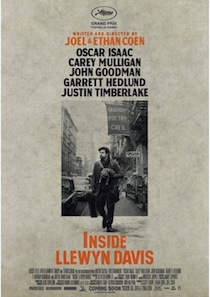 Joel and Ethan Coen return with their latest film Inside Llewyn Davis, which follows Llewyn Davis (Oscar Isaac), a brilliant folk musician, but miserable human being who is struggling to live off of his music in New York in 1961.
Joel and Ethan Coen return with their latest film Inside Llewyn Davis, which follows Llewyn Davis (Oscar Isaac), a brilliant folk musician, but miserable human being who is struggling to live off of his music in New York in 1961.
Llewyn has lost his singing partner, but carries on as a solo act, relying on the kindness of friends and acquaintances for a place to crash. The Coens submerse us in the folk music culture of the Greenwich Village scene, by introducing us to an array of characters from the duo of Jim and Jean (Justin Timberlake and Carey Mulligan) to Al Cody (Adam Driver) to the young Troy Nelson (Stark Sands). Each has their own style and helps to revive the spirit of the music of the early 1960s.
Let’s address the music specifically. The cast, from Oscar Isaac to Stark Sands, was chosen because of their ability to sing as well as act. Many of the numbers were recorded during the film takes, which gives these musical moments an immediacy that they would not have otherwise.
 By capturing a performance as it happens, the Coens can manipulate the sound design to push an artistic point. They can compress the perceived size of the room until it is just the viewer and Llewyn, as in the opening moments of the film, or they can increase the sound of the room to isolate Llewyn, as they do when Llewyn performs for Bud Grossman (F. Murray Abraham).
By capturing a performance as it happens, the Coens can manipulate the sound design to push an artistic point. They can compress the perceived size of the room until it is just the viewer and Llewyn, as in the opening moments of the film, or they can increase the sound of the room to isolate Llewyn, as they do when Llewyn performs for Bud Grossman (F. Murray Abraham).
Inside Llewyn Davis is much more than a musical conceit, more than a mere gimmick that allows talented actors to perform to the limits of their abilities. The control and opportunities allow the Coen brothers to explore the wearying lengths a not-so-young artist must go to in order to get recognized with no guarantees of fame or success.
 Llewyn travels the streets of New York looking for an angle. His personal life is in shambles, and he counts no one as a peer or equal. His life off stage is a mess, but on stage Llewyn transforms. His brilliance and control of his music and audience is uncanny. The only thing that stands in the way of his success is the slow inevitability that all of the opportunities are being handed out to those around him.
Llewyn travels the streets of New York looking for an angle. His personal life is in shambles, and he counts no one as a peer or equal. His life off stage is a mess, but on stage Llewyn transforms. His brilliance and control of his music and audience is uncanny. The only thing that stands in the way of his success is the slow inevitability that all of the opportunities are being handed out to those around him.
This sad frustration made me think of a much earlier Coen brothers film, Barton Fink. In Barton Fink a young playwright goes to Hollywood to make it big in the movie business. Barton finds out that the film industry is a vicious system that won’t allow a young artist to create the work for which he has become known.
 If Barton Fink is angry and aggressive towards an entertainment market system that restricts young artists for doing good work, then Inside Llewyn Davis is more the dull ache of sadness that follows the life of an artist who struggles to maintain their integrity in spite of the lures of easier paths.
If Barton Fink is angry and aggressive towards an entertainment market system that restricts young artists for doing good work, then Inside Llewyn Davis is more the dull ache of sadness that follows the life of an artist who struggles to maintain their integrity in spite of the lures of easier paths.
None of this message works unless we believe the main character. The sincerity mixed with awkward arrogance that Oscar Isaac develops is wonderful. Covered in a mop-like head of hair and a full beard, Isaac has only his eyes to express anger, hurt, sadness, or disdain, but each of these emotions comes through in their turn. Never once are we in doubt of the nature of Llewyn’s emotions.
 There is a moment in Inside Llewyn Davis, when Llewyn looks at Jean and tells her that he is tired. And not just the tired that requires a good night’s sleep, but something deeper, something far more stubborn. Llewyn is tired of fighting for a way of life that seeks out something beyond a good paying job, and a house in the suburbs. Anyone that has chosen Llewyn’s path, even for a short time, will understand his exhaustion.
There is a moment in Inside Llewyn Davis, when Llewyn looks at Jean and tells her that he is tired. And not just the tired that requires a good night’s sleep, but something deeper, something far more stubborn. Llewyn is tired of fighting for a way of life that seeks out something beyond a good paying job, and a house in the suburbs. Anyone that has chosen Llewyn’s path, even for a short time, will understand his exhaustion.
For me, Inside Llewyn Davis struck a nerve. Sometimes all of the elements of a film just come together in a seemingly effortless way to form a cinematic whole that is far more than a great performance or an excellent script. Inside Llewyn Davis is just such a film. I find it a deeply moving film and count it as one of my favorites of 2013.







Comments on this entry are closed.